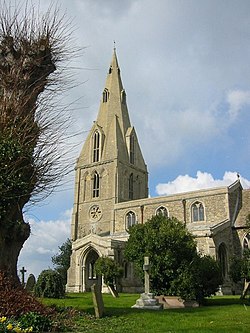Buckworth
| Buckworth | |
|---|---|
 Buckworth All Saints |
|
| Buckworth shown within Cambridgeshire | |
| Population | 181 (including Barham and Woolley. 2011) |
| OS grid reference | TL150771 |
| District | |
| Shire county | |
| Region | |
| Country | England |
| Sovereign state | United Kingdom |
| Post town | Huntingdon |
| Postcode district | PE28 |
| Dialling code | 01480 |
| EU Parliament | East of England |
Buckworth is a village and civil parish in Cambridgeshire, England. Buckworth lies approximately 7 miles (11 km) west of Huntingdon and covers an area of 2,023 acres. It is also a part of the hundred called Leightonstone. Buckworth is situated within Huntingdonshire which is a non-metropolitan district of Cambridgeshire as well as being a historic county of England.
The village is located on the slope of a hill, in the middle of farmlands and facing northeast. The road crossing Buckworth (Church Road) joins Alconbury and Barham and is the main street of the village.
According to the Dictionary of British place-names, the name of the parish comes from the "enclosure of a man called Bucc, or where bucks are kept".
In 1085 William the Conqueror ordered that a survey should be carried out across his kingdom to discover who owned which parts and what it was worth. The survey took place in 1086 and the results were recorded in what, since the 12th century, has become known as the Domesday Book. Starting with the king himself, for each landholder within a county there is a list of their estates or manors; and, for each manor, there is a summary of the resources of the manor, the amount of annual rent that was collected by the lord of the manor both in 1066 and in 1086, together with the taxable value.
Buckworth was listed in the Domesday Book in the Hundred of Leightonstone in Huntingdonshire; the name of the settlement was written as Buchesworde in the Domesday Book. In 1086 there was just one manor at Buckworth; the annual rent paid to the lord of the manor in 1066 had been £10 and the rent had increased to £13 in 1086.
...
Wikipedia

